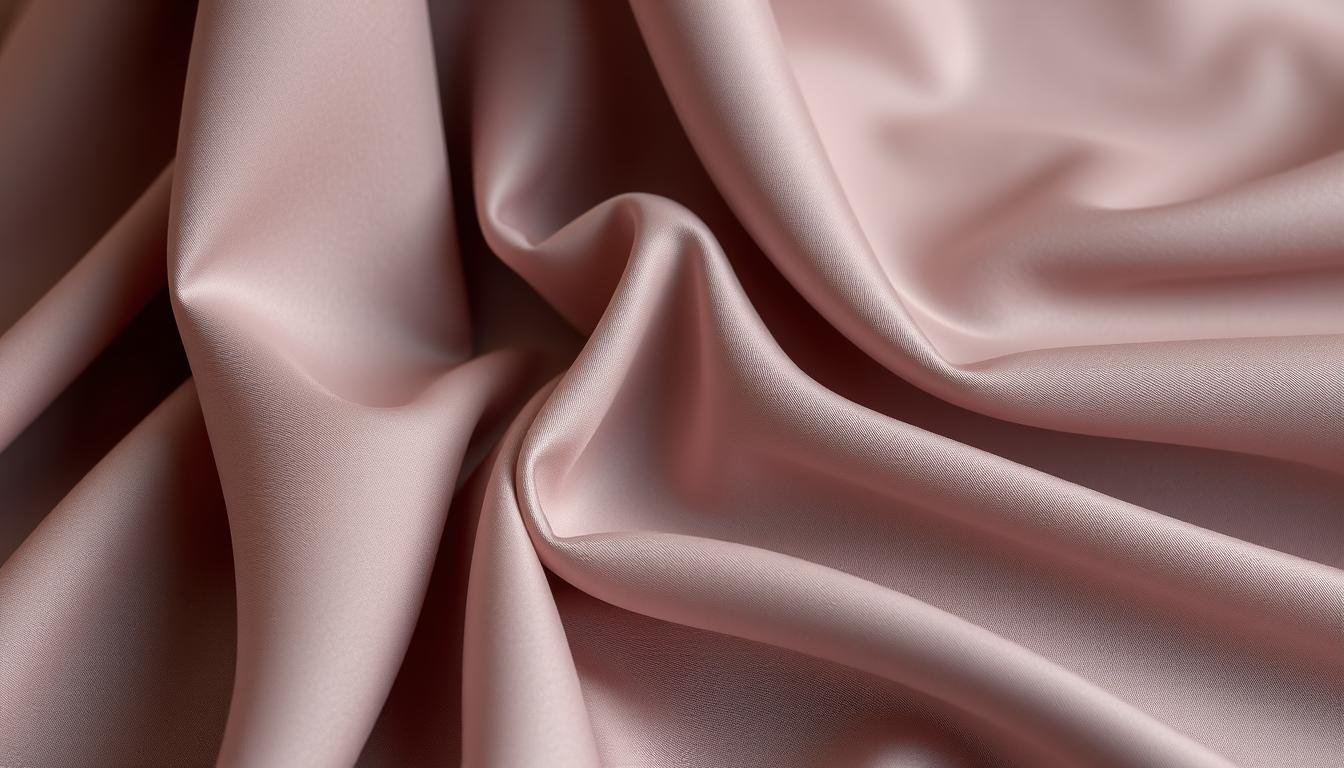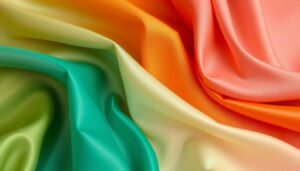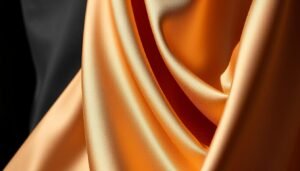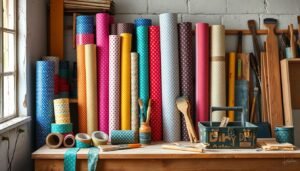“Nature does not hurry, yet everything is accomplished.” This quote by Lao Tzu reminds us of the beauty of patience and sustainability. At Beytown Textile, we see this balance in viscose fabric. It’s soft, versatile, and shows how nature and fashion can work together.
Viscose comes from wood pulp and is semi-synthetic. It’s a key player in breathable fabrics and sustainable fashion. At Beytown Textile, we know people want materials that are comfy and good for the planet. Viscose is a plant-based choice that’s perfect for those who care about the environment.
It’s great for fashion and home decor, fitting many uses while being kind to the earth. This makes viscose a top pick for those who want to look good and do good.
Key Takeaways
- Viscose fabric is a semi-synthetic textile known for its softness and breathability.
- It serves as a sustainable option in the fashion industry, appealing to eco-conscious consumers.
- Viscose effectively absorbs moisture, making it suitable for various applications including activewear.
- The fabric is versatile enough for both apparel and home furnishings.
- Viscose is made from natural materials, contributing to its eco-friendliness compared to purely synthetic options.
- While viscose offers impressive qualities, its production process can have environmental impacts that consumers should consider.
What is Viscose Fabric?
Viscose fabric, also known as rayon, comes from wood pulp of trees like pine, beech, and eucalyptus. It feels luxurious, similar to silk, making it a top choice in fashion. The making of viscose uses both chemical and mechanical methods. This makes it a semi-synthetic material with natural and synthetic benefits.
Since 1883, viscose has been a key player in the market. It’s cheaper than natural fibers like cotton and silk. Viscose can mix with other materials, making it versatile for clothes and home decor. It’s great for warm weather because it breathes well and absorbs moisture.
Viscose is also a green choice, being biodegradable. This makes it a top pick for eco-friendly fashion. Learn more about how viscose is becoming more sustainable. The demand for viscose is growing, especially as people look for natural alternatives to synthetic fabrics.
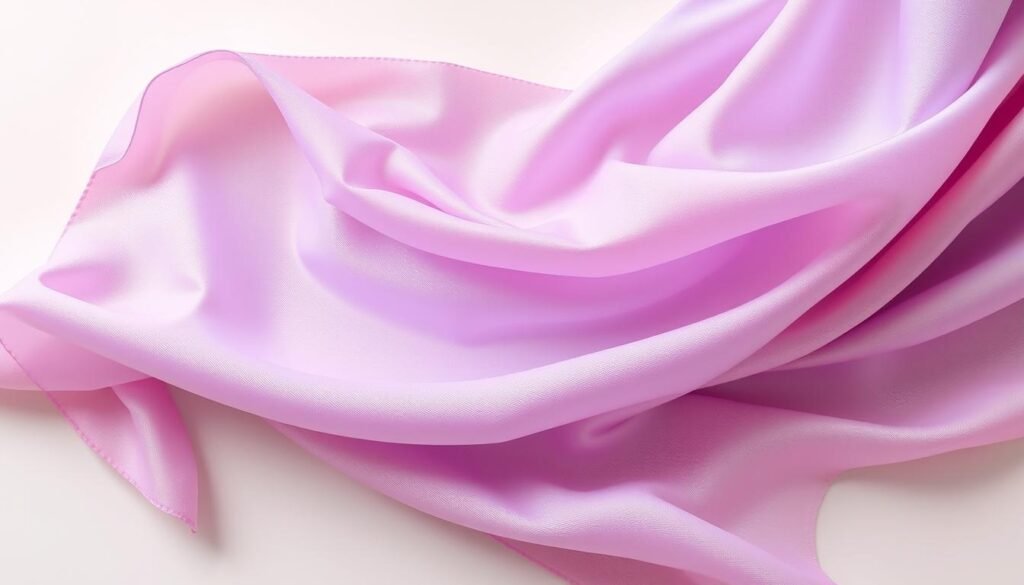
| Property | Description |
|---|---|
| Origin | Derived from wood pulp |
| Classification | Semi-synthetic material |
| Production year | First produced in 1883 |
| Breathability | Excellent moisture absorption |
| Sustainability | Biodegradable and eco-friendly |
| Market growth | Projected at 4% (2021-2026) |
Characteristics of Viscose Fabric
Viscose fabric is known for its unique qualities. These make it a favorite in the textile world. It improves how we feel when wearing different clothes.
Soft Texture and Feel
Viscose fabric is exceptionally soft. This softness makes it comfortable against our skin. It’s perfect for both casual and formal outfits. Wearing viscose makes us feel luxurious, whether it’s a dress or a blouse.
Breathtaking and Moisture Management
Viscose fabric is great at managing moisture. It absorbs sweat well, keeping us cool and dry. This makes it ideal for summer clothes and workout gear.
Lightweight and Comfort
Viscose fabric is lightweight and comfortable. It lets us move easily and feel breezy. Whether it’s dresses or trousers, viscose adds a light, airy feel to our clothes.
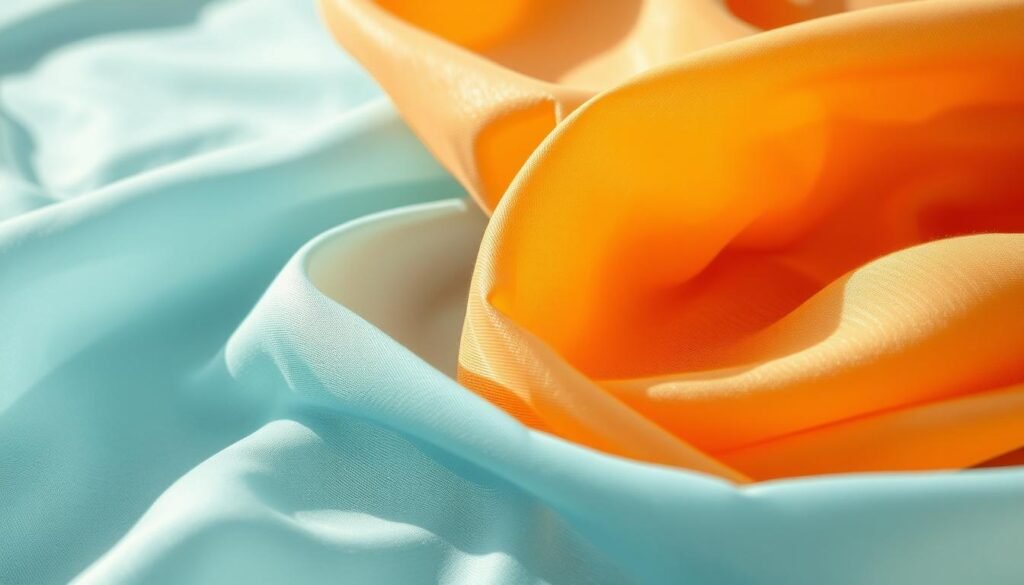
| Characteristic | Description |
|---|---|
| Softness | Feels similar to silk and is gentle on the skin. |
| Moisture-Wicking | Absorbs sweat, keeping the body dry and comfortable. |
| Lightweight | Provides airy comfort and ease of movement in clothing. |
| Breathability | Allows air circulation, making it suitable for warm climates. |
| Drapability | Offers a beautiful flow, enhancing garment style. |
Viscose Fabric vs. Other Materials
We often compare viscose fabric with cotton, polyester, and silk. Each has its own unique qualities. Knowing these differences helps us make better choices.
Comparison with Cotton
Viscose fabric is softer and shinier than cotton. It’s great for looks. Cotton is durable and breathable. Viscose is as comfy as cotton but has a special drape like silk.
Comparison with Polyester
Viscose comes from plants and breathes better than polyester. It feels luxurious and fits well with fashion. But, it wrinkles easily and isn’t as strong as polyester.
Comparison with Silk
Viscose is cheaper but still looks and feels like silk. Both are light and comfy. Silk is more durable and elegant than viscose.
| Fabric Type | Softness | Breathability | Durability | Luster |
|---|---|---|---|---|
| Viscose Fabric | High | Moderate | Low | High |
| Cotton | Moderate | High | High | Low |
| Polyester | Low | Low | High | Moderate |
| Silk | High | Moderate | High | Very High |
Manufacturing Process of Viscose Fabric
The making of viscose fabric starts with getting and preparing raw materials. We talk about the importance of knowing what goes into making it. This includes the steps to make rayon from cellulosic fibers found in trees like spruce and beech.
Raw Materials Used
Cellulose is the main part in making viscose fabric. It comes from wood pulp that is sustainable. This makes sure the fabric is of high quality and good for the environment.
Steps of Rayon Production
Rayon production involves complex steps that use advanced technology and careful methods.
- Cellulose Extraction: Cellulose is taken from trees and goes through treatments to get ready for the next steps.
- Alkali Treatment: The cellulose is mixed with sodium hydroxide, creating a viscous solution needed for the next steps.
- Xanthation: The solution is mixed with carbon disulfide, making cellulose xanthate, which is key for making fibers.
- Wet Spinning: The cellulose xanthate is pushed through spinnerets into a bath. This bath has water, sodium sulphate, glucose, and sulphuric acid.
- Filtration: The mix is filtered to remove bits that could mess up the spinning.
- Drawing and Drying: The fibers are stretched and dried, making them better.
This detailed process makes high-quality viscose fibers. These fibers can be turned into yarn. Companies like Beytown Textile use these fibers for different fabrics, like antistatic ESD fabric. This fabric helps stop static charges in certain industries. For more info, visit Beytown Textile.
Types of Viscose Fabrics
There are many types of viscose fabrics, each with its own special features. Bamboo viscose and eucalyptus viscose are two examples. They are great for sustainable fashion because of their unique qualities.
Bamboo Viscose
Bamboo viscose is known for being breathable and good at managing moisture. It comes from bamboo, a plant that grows quickly. This makes it perfect for workout clothes, keeping you cool and dry.
It’s also very light and soft, making it great for summer clothes.
Eucalyptus Viscose
Eucalyptus viscose is similar to bamboo viscose but has some differences. It’s also breathable and manages moisture well. However, growing eucalyptus can take up a lot of land, which is bad for the environment.
But, if you choose the right source and look for certifications, it can be a greener option.
Modal and Lyocell
Modal comes from the pulp of beech trees and is known for being super soft and not shrinking much. Lyocell, which includes TENCEL™, is made from eucalyptus trees and is made in a way that’s good for the planet. It’s also hypoallergenic, keeps moisture away, and doesn’t cling, making it great for workout clothes.
Here’s a quick look at how these fabrics compare:
| Type of Viscose | Breathability | Softness | Sustainability |
|---|---|---|---|
| Bamboo Viscose | High | Soft | Moderate |
| Eucalyptus Viscose | High | Soft | Variable |
| Modal | Moderate | Very Soft | High |
| Lyocell | Moderate | Soft | Very High |
When looking for sustainable fabrics, it’s important to know what’s out there. By learning about bamboo viscose, eucalyptus viscose, modal, and lyocell, we can pick the best ones for our clothes. For more info on outdoor fabrics, check out this resource.
Sustainability of Viscose Fabric
Viscose fabric is at a crossroads, blending renewable resources with environmental concerns. Its soft texture and versatility are well-known. Yet, the impact of making it is key for those who love sustainable fashion.
Eco-Friendly Alternatives
TENCEL™ and ECOVERO are leading the way with eco-friendly options. They use almost 95% less water and chemicals than traditional methods. This means they’re gentler on the planet and help cut down on waste. Brands like Eileen Fisher and Stella McCartney use viscose from well-managed forests. They show us how to choose eco-friendly alternatives that are better for the earth.
Environmental Concerns
Even though viscose comes from renewable sources, its production is a big problem. Only about 20% of ancient forests left for viscose, and 200 million trees are cut down yearly. The use of chemicals like sodium hydroxide and sulfuric acid harms nature and puts workers at risk.
These chemicals can cause burns, skin problems, and even cancer. The process also pollutes water and air, showing we need to change how viscose is made.
| Fabric Type | Sustainability Rating | Environmental Impact |
|---|---|---|
| Conventional Viscose | D | High deforestation rates, toxic emissions |
| TENCEL™ Lyocell | B | Low emissions, high recyclability, sustainable processing |
| Modal Rayon | D | Better than viscose, but still significant concerns |
| ECOVERO | B | Low environmental impact, sustainably sourced |
Applications of Viscose Fabric
Viscose fabric is versatile and plays a big role in many industries. It’s used a lot in fashion, home decor, and technical textiles. Its special features make it perfect for these areas.
Fashion and Apparel
Viscose fabric is a hit in fashion because it feels luxurious and looks great. It’s used in dresses, blouses, and lightweight tops. People love it for being soft and keeping colors bright, even after many washes.
Home Furnishings
At home, viscose fabric is popular for curtains, upholstery, and bed linens. It makes spaces feel welcoming with its softness and texture. Viscose absorbs dyes well, making furniture look stylish and bright.
Technical Textiles
Viscose also has uses in technical textiles. It’s used in medical textiles and hygiene products because it’s soft and doesn’t cause allergies. Its ability to absorb moisture makes it great for many industries.
Care Instructions for Viscose Fabric
To keep viscose fabric looking great, follow these care tips. Always hand wash in cold water with a gentle detergent. This helps prevent shrinking and damage. For machine washable items, use a gentle cycle, turn them inside out, and put them in a mesh bag to avoid snags.
Check out our washing tips for more advice.
Washing and Drying Tips
Air drying is best for viscose clothes. Lay them flat on a rack or hang them up to keep their shape. Avoid using the dryer as it can damage the fabric.
For getting rid of wrinkles, use a steamer. It’s safe and keeps the fabric looking good.
Handling and Storage
Be gentle when handling viscose fabric. Fold knit items and hang woven ones to avoid damage. Use cotton storage bags to keep them clean and pest-free.
Don’t store viscose in plastic as it can cause moisture and yellowing. Proper storage helps your viscose items last longer.
FAQ
What is viscose fabric made from?
Viscose fabric, also known as rayon, comes from wood pulp. It’s a semi-synthetic textile made from plant-based materials.
Is viscose fabric sustainable?
Viscose is made from renewable resources but its production can harm the environment. Eco-friendly options like Tencel focus on sustainability and reduce environmental damage.
How does viscose compare to cotton?
Viscose is softer and has a luxurious sheen than cotton. Cotton is durable and breathable. Viscose has a unique drape that can mimic silk, making it great for fashion.
Can viscose fabric wick moisture?
Yes, viscose absorbs sweat well due to its moisture-wicking properties. It’s breathable, making it comfy in warm weather.
What are the different types of viscose fabrics?
There are various viscose fabrics. Bamboo viscose is breathable and eco-friendly. Eucalyptus viscose is similar but has environmental concerns. Modal is soft and doesn’t shrink much. Lyocell is made sustainably.
How should I care for viscose fabric?
Wash viscose on a gentle cycle with cold water. Hand washing is best. Air dry it to avoid shrinkage. Handle it gently to keep the fibers intact.
What applications is viscose fabric commonly used for?
Viscose is used in fashion for dresses and blouses because of its luxurious feel. It’s also in home decor like curtains and upholstery. It’s used in technical textiles for softness and moisture absorption.
Is viscose fabric biodegradable?
Yes, viscose fabric breaks down naturally, making it a good choice for sustainable fashion. It’s a better option than fully synthetic textiles.

